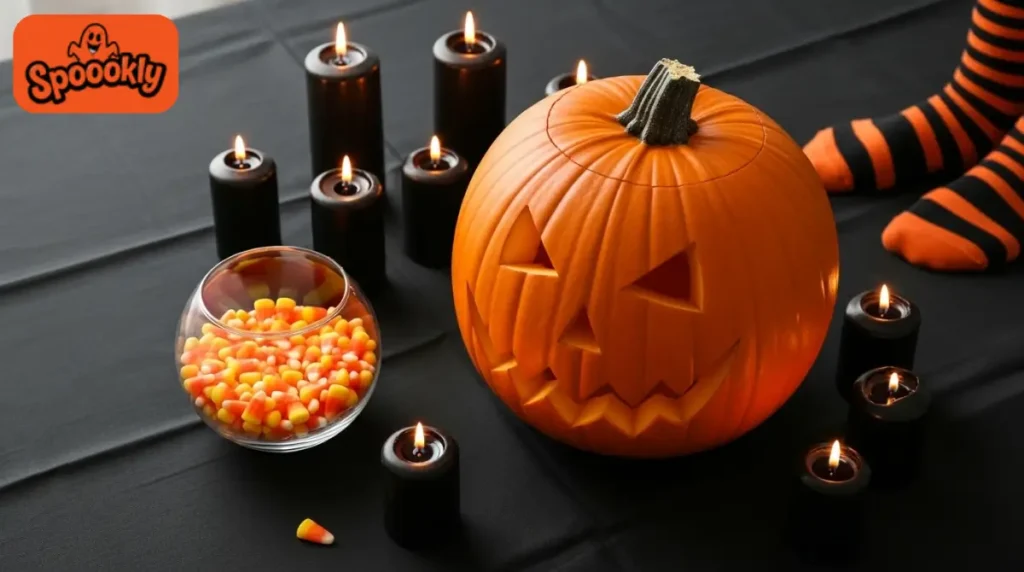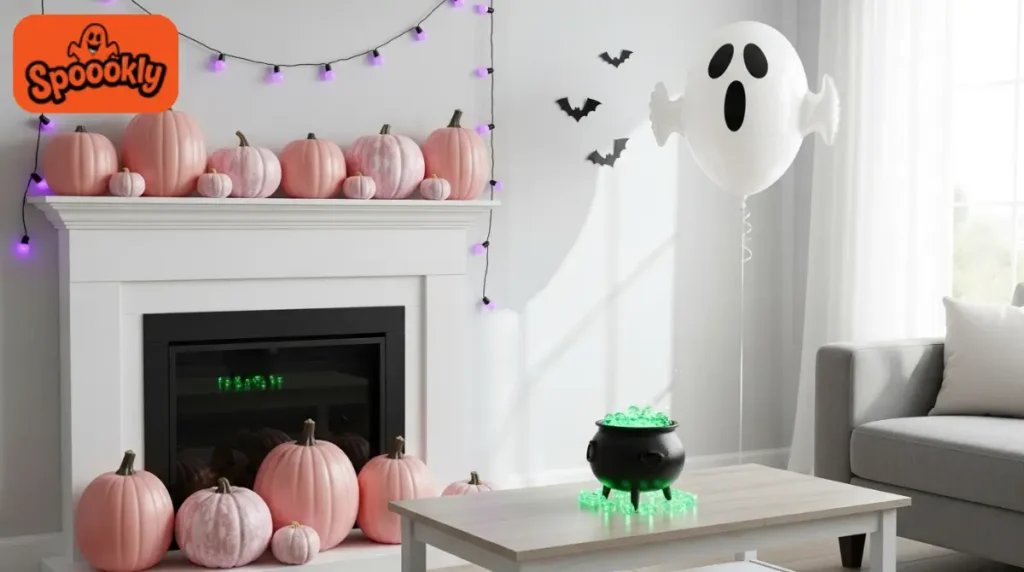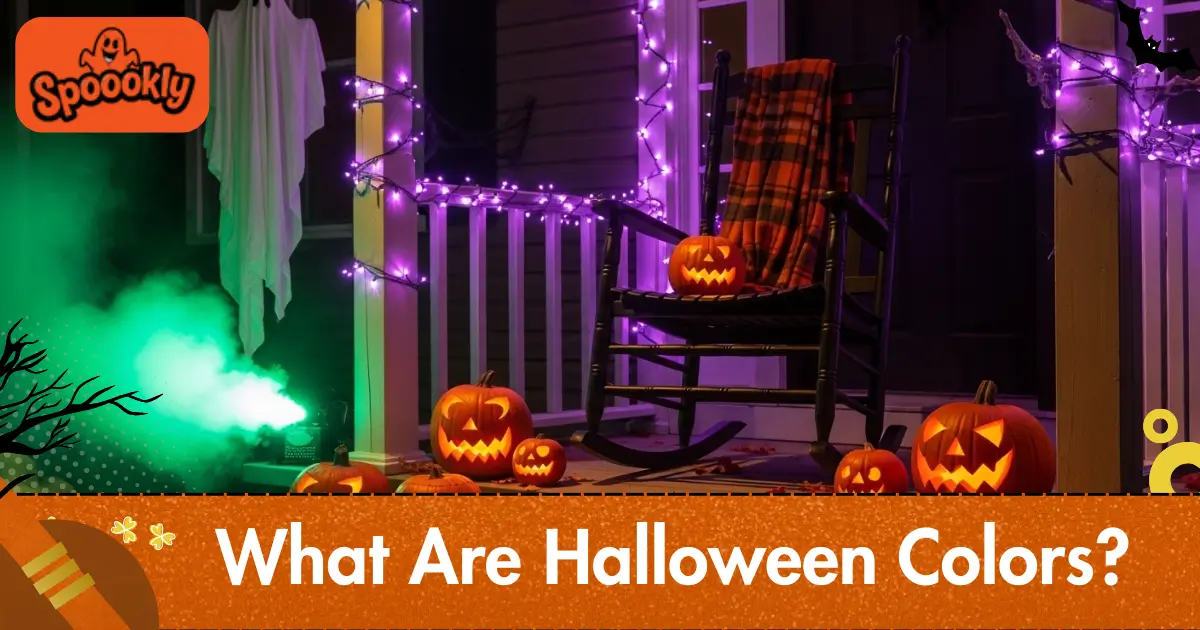The classic Halloween colors are black and orange. They’re the shades that instantly set the spooky mood every October.
Along with them, purple and green have become common accents, while white, red, or even trendy pastels sometimes sneak into modern decorations.
Why Colors Matter at Halloween
Halloween isn’t only about pumpkins, candy, or costumes. The color palette plays a big role in how we feel about the holiday.
Imagine orange pumpkins glowing in the night against a black sky that contrast is what gives Halloween its recognizable look. These colors shape our mood, create atmosphere, and help traditions feel alive year after year.
I’ve noticed that whenever I decorate my home or even browse store aisles, the colors jump out before anything else. They tell me, “Halloween has arrived.”
The Two Core Halloween Colors: Black and Orange
Why Orange Is a Halloween Color
Orange is everywhere during Halloween. Pumpkins, jack-o’-lanterns, autumn leaves, and even firelight all bring this shade to life. Orange represents:
- Harvest and abundance (linking back to Samhain and fall festivals).
- Warmth and fire, which people once used to guard against spirits.
- Life and energy, balancing the darker tones of the holiday.
It makes sense: October is harvest season, and orange captures that exact feeling of fullness and change.
Why Black Is a Halloween Color
If orange celebrates life, black reminds us of mystery and endings. It has always been tied to:
- Night and darkness
- Death and mourning
- The unknown and supernatural
In older traditions, people believed Halloween marked a thin veil between the living and the dead. Black symbolized that threshold. Even today, when I walk past a house covered in black cloth and shadows, it feels instantly more haunting.
How Black and Orange Work Together
On their own, black and orange are strong. Together, they’re iconic. The brightness of orange pops against the depth of black, creating balance between light and dark, life and death.
That’s why every Halloween aisle, logo, or party invite usually combines both. They’ve become the foundation of the Halloween color palette, and removing them would almost feel wrong.

Accent Colors That Complete the Palette
Purple: The Color of Magic
Purple adds mystery and a touch of fantasy. It connects to witchcraft, magic, and the supernatural.
Purple lights, tablecloths, and even smoke effects give Halloween events a more mystical vibe. Personally, I think adding a bit of purple makes décor less gloomy and more playful.
Green: Eerie and Unnatural
Halloween green isn’t the calm forest green you see in spring. It’s the bright, glowing green that screams “slime, monsters, and toxic potions.” It shows up in Frankenstein costumes, bubbling cauldrons, and eerie lighting.
Green brings the “unnatural” element, making everything feel a bit more otherworldly. Without it, haunted houses would lose some of their edge.
Halloween Colors & Their Meanings
| Color | Symbolism | Common Uses |
|---|---|---|
| Orange | Harvest, fire, life | Pumpkins, leaves, lanterns |
| Black | Night, death, mystery | Costumes, backgrounds, shadows |
| Purple | Magic, witchcraft, mysticism | Lights, fabrics, potions |
| Green | Monsters, slime, unnatural energy | Lighting, décor, costumes |
More Accent Colors in the Halloween Palette
White: Ghostly and Stark
White is often overlooked, but it plays a big role in Halloween. It represents ghosts, skeletons, cobwebs, and eerie fog. White also provides contrast, making darker colors stand out more.
A black spider web painted against a white wall instantly feels spookier. Without white, many Halloween decorations would lose their definition.
Red: Blood and Intensity
Red isn’t always part of the “classic” Halloween palette, but it has its place. Think vampires, blood, and danger. A splash of red adds drama, heightening fear and intensity.
Haunted houses often use red lights to suggest something sinister. I’ve noticed that even a single red element like fake blood on a pumpkin changes the entire mood.
Blue and Teal: Mysterious Variations
While less common, shades of blue or teal sometimes appear in Halloween setups. Blue lighting creates a cold, spectral atmosphere, while teal has become a trendy modern choice for pumpkins.
Some families even use teal pumpkins to show they’re offering allergy-friendly treats. This mix of symbolism and practicality proves that color choices evolve with traditions.
Pastels and “Pinkoween” Trends
In recent years, pastel Halloween themes have become surprisingly popular. Pink, lavender, and baby blue aren’t scary, but they bring a whimsical vibe.
“Pinkoween” decor mixes sweetness with spooky, think candy-colored pumpkins and soft-hued bats. While it’s not traditional, it’s proof that Halloween colors continue to grow beyond black and orange.
Color Psychology and Symbolism in Halloween
Colors don’t just look nice, they affect how we feel. Here’s how common Halloween colors play with our emotions:
- Black creates fear, mystery, and suspense.
- Orange feels warm, welcoming, and festive.
- Purple sparks imagination and magical curiosity.
- Green brings unease, signaling poison or monsters.
- White feels chilling, like emptiness or ghosts.
- Red raises adrenaline with its link to blood and danger.
When combined, these shades balance fun and fear. That’s what makes Halloween decor both inviting and spooky.

Color Mood Chart for Halloween
| Color | Mood Created | Best For |
|---|---|---|
| Black | Suspense, fear, mystery | Backgrounds, shadows, costumes |
| Orange | Warmth, festivity, comfort | Pumpkins, lights, banners |
| Purple | Magic, mystery, fantasy | Lighting, fabrics, potion décor |
| Green | Unease, toxicity, monsters | Slime props, eerie glow |
| White | Coldness, ghostly presence | Fog, skeletons, contrast |
| Red | Danger, intensity, shock | Fake blood, dramatic lighting |
Using Halloween Colors in Design and Decor
Choosing a Color Palette
The easiest way to plan a Halloween setup is to pick one primary color (black or orange) and add two accent colors (like purple or green). This gives balance without overwhelming the eyes.
For example:
- Classic combo: Black + Orange + White
- Spooky combo: Black + Purple + Green
- Trendy combo: Black + Orange + Pink
Color Combinations That Work
Here are a few ready-made palettes:
- Haunted Harvest: Orange, black, white
- Witch’s Night: Black, purple, green
- Bloody Vampire: Black, red, silver
- Pinkoween Playful: Black, pastel pink, lavender
I’ve tried mixing purple lights with orange pumpkins, and the effect is both fun and eerie. It shows how color alone can transform a space.
Practical Tips for Home Decor and Parties
- Use orange lights outside and black accents inside for instant atmosphere.
- Add green glow sticks to cauldrons for a bubbling effect.
- Mix purple tablecloths with black plates for a witchy dinner theme.
- For a softer style, spray-paint pumpkins in pastel shades.
Even small touches like a white ghost balloon in a black room can completely shift the mood.
Examples and Inspiration for Halloween Colors
When I decorate for Halloween, I always look for ways to mix colors that feel classic but not boring. Here are a few examples that can inspire you too.
- Interior setups: Orange throw pillows with black blankets instantly create seasonal vibes in a living room. Add purple candles for a magical twist.
- Party themes: A black table with orange plates, green drinks, and purple napkins looks like it came straight out of a witch’s cookbook.
- Outdoor décor: White cobwebs against black trees, orange lanterns, and a splash of eerie green lighting make the yard look professionally staged.
I’ve even seen businesses paint entire storefronts in pastel pink for “Pinkoween.” It looks playful and makes people stop for photos, which is great for attention.
Sample Halloween Color Palettes
| Palette Name | Colors Included | Perfect For |
|---|---|---|
| Classic Harvest | Black, Orange, White | Traditional décor, pumpkins, trick-or-treat night |
| Witchy Magic | Black, Purple, Green | Haunted houses, parties, spooky invites |
| Vampire Gothic | Black, Red, Silver | Horror themes, vampire nights |
| Pinkoween Trend | Black, Pink, Lavender | Modern décor, Instagram-friendly setups |
| Ghostly Chill | White, Black, Blue | Minimalist spooky designs |
Conclusion
Halloween colors go beyond decoration. Black and orange symbolize the cycle of life and death, while purple, green, white, and red add depth and variety.
Together, they set the mood sometimes eerie, sometimes playful, but always unmistakably Halloween.
My advice? Don’t feel locked into tradition. Experiment with accents or even modern palettes like pastels. Whether you want scary, stylish, or simply fun, the right mix of colors can transform your space.
Halloween is all about atmosphere, and colors are the fastest way to create it. The moment someone sees your orange pumpkins glowing against the black night, they’ll know exactly what season it is.
FAQs
No, but they’re the most iconic. If you want instant recognition, black and orange are the safest choices.
Yes. Purple, green, white, and even pastel shades are widely used today.
Purple connects to magic, witchcraft, and mystery, making it a natural fit for Halloween themes.
It’s a playful trend where pastel colors, especially pink, replace the traditional spooky palette. It softens Halloween while keeping it stylish.
Choose one main color (black or orange) and two accent shades. Test small decorations first, then expand once you’re happy with the vibe.

